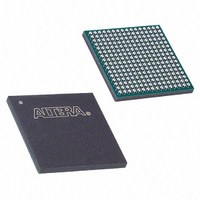EPM1270F256I5 Altera, EPM1270F256I5 Datasheet - Page 17

EPM1270F256I5
Manufacturer Part Number
EPM1270F256I5
Description
IC MAX II CPLD 1270 LE 256-FBGA
Manufacturer
Altera
Series
MAX® IIr
Specifications of EPM1270F256I5
Programmable Type
In System Programmable
Delay Time Tpd(1) Max
6.2ns
Voltage Supply - Internal
2.5V, 3.3V
Number Of Logic Elements/blocks
1270
Number Of Macrocells
980
Number Of I /o
212
Operating Temperature
-40°C ~ 100°C
Mounting Type
Surface Mount
Package / Case
256-FBGA
Voltage
2.5V, 3.3V
Memory Type
FLASH
Number Of Logic Elements/cells
1270
Family Name
MAX II
# Macrocells
980
Frequency (max)
1.8797GHz
Propagation Delay Time
10ns
Number Of Logic Blocks/elements
127
# I/os (max)
212
Operating Supply Voltage (typ)
2.5/3.3V
In System Programmable
Yes
Operating Supply Voltage (min)
2.375V
Operating Supply Voltage (max)
3.6V
Operating Temp Range
-40C to 100C
Operating Temperature Classification
Industrial
Mounting
Surface Mount
Pin Count
256
Package Type
FBGA
For Use With
544-2380 - KIT DEV MAXII W/EPM 1270N
Lead Free Status / RoHS Status
Contains lead / RoHS non-compliant
Features
-
Lead Free Status / Rohs Status
Not Compliant
Other names
544-1381
EPM1270F256I5
EPM1270F256I5
Available stocks
Company
Part Number
Manufacturer
Quantity
Price
Company:
Part Number:
EPM1270F256I5
Manufacturer:
ALTERA
Quantity:
198
Part Number:
EPM1270F256I5
Manufacturer:
ALTERA/阿尔特拉
Quantity:
20 000
Company:
Part Number:
EPM1270F256I5N
Manufacturer:
ALTERA
Quantity:
165
Company:
Part Number:
EPM1270F256I5N
Manufacturer:
ALTERA
Quantity:
297
Part Number:
EPM1270F256I5N
Manufacturer:
ALTERA/阿尔特拉
Quantity:
20 000
Chapter 2: MAX II Architecture
Logic Elements
Figure 2–7. LE in Normal Mode
Note to
(1) This signal is only allowed in normal mode if the LE is at the end of an adder/subtractor chain.
© October 2008 Altera Corporation
addnsub (LAB Wide)
Figure
data1
data2
data3
cin (from cout
of previous LE)
data4
2–7:
(1)
Normal Mode
The normal mode is suitable for general logic applications and combinational
functions. In normal mode, four data inputs from the LAB local interconnect are
inputs to a four-input LUT (see
selects the carry-in or the data3 signal as one of the inputs to the LUT. Each LE can use
LUT chain connections to drive its combinational output directly to the next LE in the
LAB. Asynchronous load data for the register comes from the data3 input of the LE.
LEs in normal mode support packed registers.
Dynamic Arithmetic Mode
The dynamic arithmetic mode is ideal for implementing adders, counters,
accumulators, wide parity functions, and comparators. An LE in dynamic arithmetic
mode uses four 2-input LUTs configurable as a dynamic adder/subtractor. The first
two 2-input LUTs compute two summations based on a possible carry-in of 1 or 0; the
other two LUTs generate carry outputs for the two chains of the carry-select circuitry.
As shown in
carry-in1 chain. The selected chain’s logic level in turn determines which parallel sum
is generated as a combinational or registered output. For example, when
implementing an adder, the sum output is the selection of two possible calculated
sums:
data1 + data2 + carry in0
or
data1 + data2 + carry-in1
Register Feedback
4-Input
Figure
LUT
Register chain
connection
2–8, the LAB carry-in signal selects either the carry-in0 or
clock (LAB Wide)
(LAB Wide)
ena (LAB Wide)
aclr (LAB Wide)
sload
Figure
(LAB Wide)
sclear
2–7). The Quartus II Compiler automatically
(LAB Wide)
ADATA
ENA
D
ALD/PRE
aload
CLRN
Q
MAX II Device Handbook
Row, column, and
DirectLink routing
Row, column, and
DirectLink routing
Local routing
LUT chain
connection
Register
chain output
2–9














